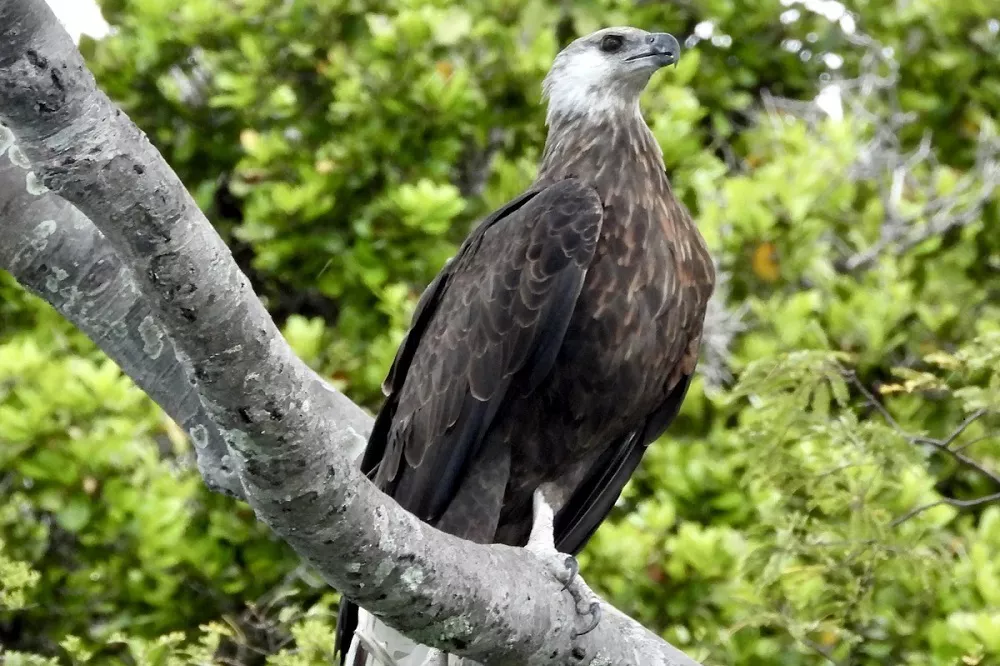The Madagascar Fish Eagle (Haliaeetus vociferoides) is a critically endangered bird species endemic to the island of Madagascar off the coast of Africa. With its striking appearance, specialized hunting techniques, and conservation status, the Madagascar Fish Eagle holds a significant place in the natural heritage of this biodiverse island. This article aims to delve into the characteristics and significance of this remarkable raptor.
Appearance and Characteristics:
The Madagascar Fish Eagle is a large bird with an imposing presence. It typically measures around 70 to 75 centimeters in length, with a wingspan of approximately 2 meters and can weigh up to 4 kilograms.. Adults display a distinctive plumage, consisting of a dark brown body and contrasting white head, neck, and tail, as well as a striking yellow beak and eyes. The eagles’ vocalizations are also unique, consisting of a series of high-pitched whistles and screams. The plumage of juveniles, on the other hand, is brown overall with a creamy white underbelly.
One of the most striking features of the Madagascar Fish Eagle is its powerful, curved beak. Adapted for tearing apart prey, this hooked beak enables the eagle to catch and consume its primary food source: fish. although it also feeds on other prey such as lemurs, reptiles and birds. The Eagles hunt for prey by flying over bodies of water and then diving near the surface to catch fish. They are able to grab prey with their strong, sharp claws and carry it to a perch where they can eat it. Breeding occurs during the dry season, May to October, in pairs that build large nests on tree forks near bodies of water. Females typically lay two eggs, but usually only one chick survives to fledgling.
See Also
Habitat and Distribution:
As its name suggests, the Madagascar Fish Eagle is primarily associated with wetland habitats and water bodies. It can be found along Madagascar’s numerous rivers, lakes, and coastal areas. The species has been observed in regions such as Lake Alaotra, Lake Ampitabe, and the Mangoky River.
Endemism to Madagascar:
The Madagascar Fish Eagle holds a special place in the avian world due to its endemic nature. Endemism refers to the occurrence of a species solely in a particular geographic region. This bird is unique to Madagascar, making it an important symbol of the island’s rich biodiversity.
Conservation Status and Threats:
Regrettably, the Madagascar Fish Eagle is listed as critically endangered by the International Union for Conservation of Nature (IUCN). The primary threat to the species is habitat loss, as Madagascar’s forests and wetlands are being destroyed at an alarming rate due to logging, agriculture, and development. This destruction of habitat has led to a decline in prey populations, which has in turn affected the eagles’ ability to reproduce successfully.
Another major threat to the Madagascar Fish Eagle comes from human persecution. The eagles are often shot or trapped by farmers and fishermen who see them as a threat to their livelihoods. In addition, the use of pesticides and other chemicals in agriculture can contaminate the eagles’ food sources and poison them directly.
Conservation Efforts:
Given the precarious state of the Madagascar Fish Eagle population, conservation efforts are urgently needed to protect this important species. One of the most important steps in protecting the eagles is to preserve their habitat. This can be achieved through the creation of protected areas, such as national parks and wildlife reserves, where the eagles can live and breed without disturbance.
Another important aspect of conservation efforts for the Madagascar Fish Eagle is to reduce human persecution of the species. This can be achieved through education and outreach programs that raise awareness of the importance of the eagles to the ecology and culture of Madagascar. Alternative livelihoods can also be provided to farmers and fishermen who might otherwise view the eagles as a threat to their incomes.
Finally, captive breeding programs can help to boost the numbers of Madagascar Fish Eagles in the wild. These programs involve breeding pairs of eagles in captivity and then releasing their offspring into the wild to supplement the existing population. This approach has been successful with other endangered bird species and could be an effective tool in the conservation of the Madagascar Fish Eagle.
Role in the Ecosystem:
The Madagascar Fish Eagle plays a vital role in maintaining the ecological balance of Madagascar’s wetland ecosystems. As an apex predator, it helps regulate fish populations, preventing overgrowth and preserving the health of aquatic environments. By conserving this species, we indirectly safeguard the integrity and functionality of the broader ecosystem it inhabits.
Conclusion:
The Madagascar Fish Eagle is a critically endangered species that faces numerous threats to its survival. However, with concerted conservation efforts, it is still possible to protect this important bird and ensure that it remains a part of the ecology and culture of Madagascar for generations to come. By preserving habitat, reducing human persecution, and using innovative conservation techniques such as captive breeding, we can help to ensure that the Madagascar Fish Eagle continues to soar over the island’s waters for years to come.


 Facebook
Facebook  Instagram
Instagram  Youtube
Youtube 